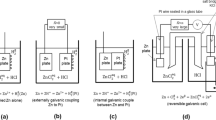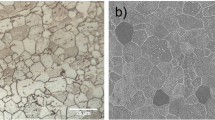Abstract
The objective of this study was to characterize the polarization impedance (resistance and capacitance) of several common metal/0.9% saline interfaces operated at low-current density and to thereby provide a useful reference for those wishing to calculate the impedance of such electrodes. The series-equivalent resistance (R) and capacitive reactance (Xc) of stainless steel, platinum, silver, MP35N, palladium, aluminum, rhodium and copper electrodes, all having a surface areas S=0.005 cm2 and all in contact with 0.9% saline, were measured as a function of frequency (100 Hz to 20 kHz) at low-current density (0.025 mA/cm2). For all the metals tested, both R and Xc decreased with increasing frequency and the relationships were linear on a log-log plot. That is, R and Xc exhibited power-law behavior (R=A/fα and Xc=B/fβ). However, it was not generally true that A=B and α=β=0.5 as stated in the Warburg low-current density model. Furthermore, the Fricke constant phase model in which α=β and ϕ=0.5πβ was found not to be applicable in general. In particular, the constraint that α=β was a good approximation for most of the metals tested in this study, but the constraint that ϕ=0.5πβ did not hold in general. Although the Warburg low-current density model provides a useful conceptual tool, it is not the most accurate representation of the electrode-electrolyte interface. The Fricke constant phase model is a better representation of electrode behavior, but it also may not be valid in general. We have found that a better representation is provided by the general power-law model R=A/fα and Xc=B/fβ, where A, B, α, and β depend on the species of both the metal and electrolyte and A and B depend, in addition, on electrode area. Using this model and the data presented in this study, the impedance of an electrode-electrolyte interface operated at low-current density may be calculated as
where S is the surface area of the electrode in cm2.
Similar content being viewed by others
References
Fricke, H. The theory of electrolyte polarization. Phil. Mag. 14:310–318; 1932.
Geddes, L.A.; DaCosta, C.P.; Wise, G. The impedance of stainless steel electrodes. Med. Biol. Eng. Comput. 9:511–521; 1971.
Geddes, L.A. Electrodes and the measurement of bioelectric events. New York: Wiley Interscience; 1972.
Gesteland, R.C.; Howland, B.; Lettvin, J.Y.; Pitts, W.H. Comments on microelectrodes. Proceedings of the Institute of Radio Engineers. 47; 11:1856–1862; 1956.
Jones, G.J.; Christian, S.M. The measurement of the conductance of electrolytes. VI. Galvanic polarization by alternating current. J. Am. Chem. Soc. 57:272–280; 1935.
Jones, G.J.; Bollinger, D.M. The measurement of the conductance of electrolytes. VII. On platinization. J. Am. Chem. Soc. 57:280–284; 1935.
Macdonald, J.R. Impedance spectroscopy. New York: Wiley Interscience; 1987.
Onaral, B.; Schwan, H.P. Linear and nonlinear properties of electrode polarization. Part 1; Frequency dependence at very low frequencies. Med. Biol. Eng. Comput. 20:299–306; 1982.
Ragheb, T.; Geddes, L.A. The electrical properties of metallic electrodes. Med. Biol. Eng. Comput. 28:182–186; 1990.
Schwan, H.P. Determination of biological impedance. In: Nastuk, W., ed. Physical techniques in biological research. New York: New York Academy of Sciences; 1963: pp. 323–407.
Schwan, H.P. Electrode polarization in ac steady-state impedance studies of biological systems. Dig. 6th Int. Conf. Med. Elec. Biol. Eng. Tokyo, Japan, paper 33-1; 1965.
Sun H.H.; Onaral, B. A unified approach to represent metal electrode polarization. IEEE Trans. Biomed. Eng. BME-30:399–406; 1983.
Warburg, E. Ueber das verhalten sogenannter unpolarisierbarer elektroden gegen wechselstrom. Ann. Physik und Chemie. 67:493–499; 1899.
Author information
Authors and Affiliations
Rights and permissions
About this article
Cite this article
Ragheb, T., Geddes, L.A. The polarization impedance of common electrode metals operated at low current density. Ann Biomed Eng 19, 151–163 (1991). https://doi.org/10.1007/BF02368466
Received:
Revised:
Issue Date:
DOI: https://doi.org/10.1007/BF02368466




